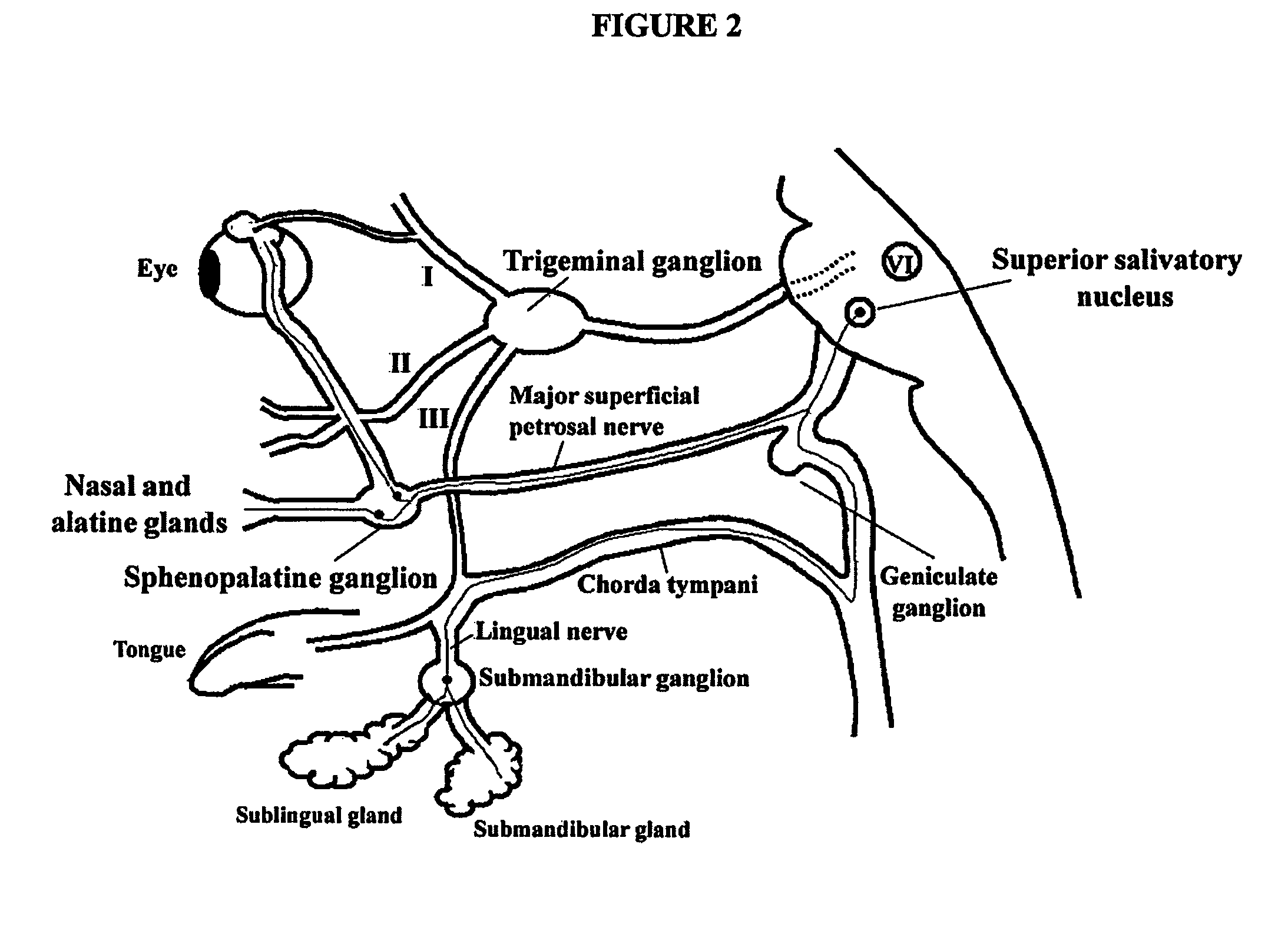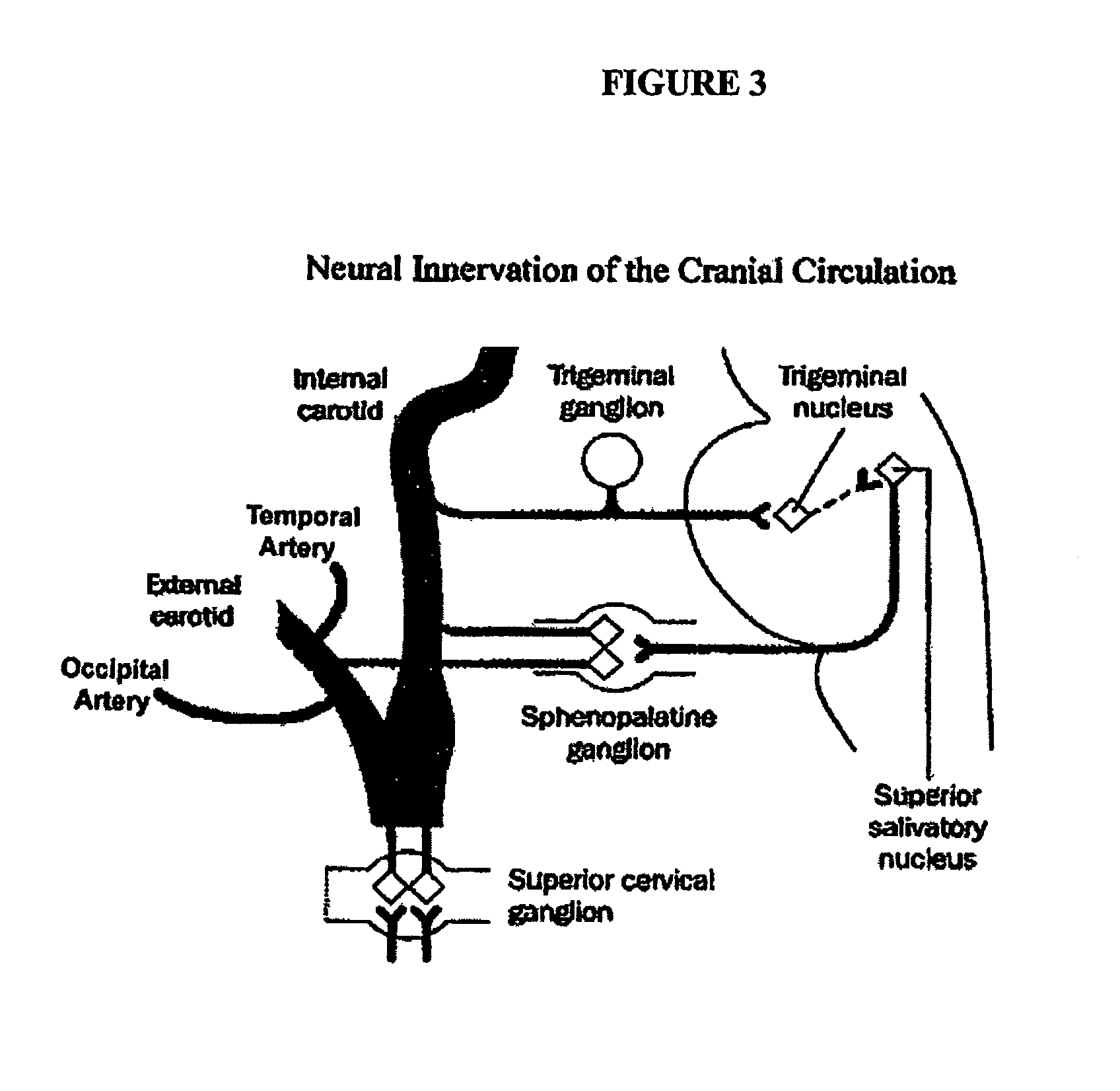Targeted delivery of botulinum toxin to the sphenopalatine ganglion
a botulinum toxin and sphenopalatine technology, applied in the direction of antibody medical ingredients, peptide/protein ingredients, metabolism disorders, etc., can solve the problems of migraine, referred pain anywhere along the trigeminal network, vision loss and jaw pain, and achieve effective therapeutic and prophylactic treatment of migraines, tac, and other headaches, reducing or preventing symptoms
- Summary
- Abstract
- Description
- Claims
- Application Information
AI Technical Summary
Benefits of technology
Problems solved by technology
Method used
Image
Examples
example 1
[0068]A 48 yr. old female patient with chronic migraine associated with rhinorrhea and cervical dystonia was treated with the disclosed intranasal method. Her migraines involved the left hemicranium and were associated with left rhinorrhea. Initial Botulinum toxin treatment using migraine and cervical dystonia protocols improved her headaches, but did not completely abort them, while the rhinorrhea persisted. The patient was treated with intranasal injections of BOTOX® 2.5 units (4 cc dilution) four times on the left side only, using the needle palpation approach. There was no change in the shape of the nose or the cartilage base. The discomfort was minimal and the bleeding was not excessive. Two weeks after the treatment, both the rhinorrhea and the headache were resolved.
[0069]Temporal Administration
[0070]To target the extracranial trigeminal nerve endings in the temporal region, the extracranial temporal artery is palpated and the skin is marked where the artery's pulsations are ...
example 2
[0088]A female patient presents with chronic migraines. Her migraines involved the right hemicranium. The patient is treated with a sphenopalatine ganglion targeted injection of BOTOX® of about 100 units (in a 1 cc dilution) in a continuous injection method on the right side only, using the disclosed technique, to distribute the toxin around the sphenopalatine ganglion (thus minimizing / avoiding administration of toxin to the temporalis muscle). The discomfort is minimal and the bleeding is not excessive. The patient remains upright (e.g. substantially vertical) after toxin administration (from about 15 min to 3 hours, more preferably from about 1 to about 3 hours and most preferably from about 2 to about 3 hours), to allow toxin to remain concentrated at the sphenopalatine ganglion and not be distributed throughout the temporalis muscle. Two weeks after the treatment, the headache is resolved.
example 3
[0089]A male patient presents with bilateral cluster headaches. The patient is treated with bilateral sphenopalatine ganglion injections of BOTOX® (botulinum toxin type A at 50 units per side, (in a 1 cc dilution, i.e. 50 units per / cc / side) at a plurality of sites along the injection needle track, around the sphenopalatine ganglion (thus minimizing / avoiding administration of toxin to the temporalis muscle). The discomfort is minimal and the bleeding is not excessive. The patient remains upright (e.g. substantially vertical) after toxin administration (from about 15 min to 3 hours, more preferably from about 1 to about 3 hours and most preferably from about 2 to about 3 hours), to allow toxin to remain concentrated at the sphenopalatine ganglion and not be distributed through out the temporalis muscle, as above. Two weeks after the treatment, the headache is resolved.
PUM
| Property | Measurement | Unit |
|---|---|---|
| angle | aaaaa | aaaaa |
| sizes | aaaaa | aaaaa |
| Angle | aaaaa | aaaaa |
Abstract
Description
Claims
Application Information
 Login to View More
Login to View More - R&D
- Intellectual Property
- Life Sciences
- Materials
- Tech Scout
- Unparalleled Data Quality
- Higher Quality Content
- 60% Fewer Hallucinations
Browse by: Latest US Patents, China's latest patents, Technical Efficacy Thesaurus, Application Domain, Technology Topic, Popular Technical Reports.
© 2025 PatSnap. All rights reserved.Legal|Privacy policy|Modern Slavery Act Transparency Statement|Sitemap|About US| Contact US: help@patsnap.com



